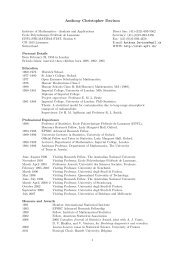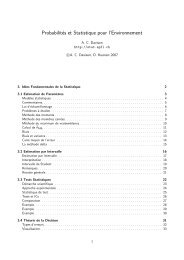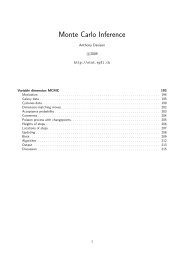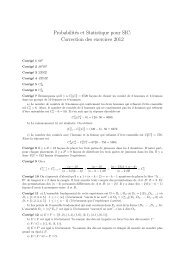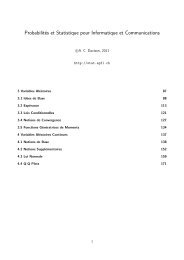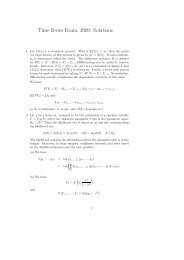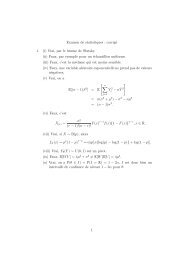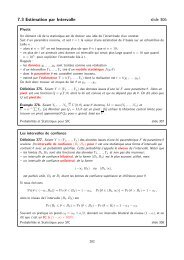Time Series Exam, 2010: Solutions - STAT
Time Series Exam, 2010: Solutions - STAT
Time Series Exam, 2010: Solutions - STAT
You also want an ePaper? Increase the reach of your titles
YUMPU automatically turns print PDFs into web optimized ePapers that Google loves.
<strong>Time</strong> <strong>Series</strong> <strong>Exam</strong>, <strong>2010</strong>: <strong>Solutions</strong><br />
1. The autocorrelation function (ACF) of a process Y t is defined as<br />
ρ(s,t) =<br />
γ(s,t)<br />
√<br />
γ(s,s)γ(t,t)<br />
,<br />
where<br />
γ(s,t) = E[(Y s −E(Y s ))(Y t −E(Y t ))]<br />
is the autocovariance function, provided the expectations exist.<br />
A strictly stationary time series is one for which the probabilistic behavior of every collection<br />
of values {Y t1 ,Y t2 ,...,Y tk } is identical to that of the time shifted set {Y t1+h,Y t2+h,...,Y tk +h}.<br />
That is,<br />
P{Y t1 ≤ c 1 ,...,Y tk ≤ c k } = Prob{Y t1+h ≤ c 1 ,...,Y tk +h ≤ c k }<br />
for all k = 1,2,..., all time points t 1 ,t 2 ,...,t k , all numbers c 1 ,c 2 ,...,c k , and all time shifts<br />
h = 0,±1,±2,....<br />
A second-order stationary time series, Y t , is a finite variance process such that<br />
(a) the mean value function, µ t = E(Y t ) is constant and does not depend on time t, and<br />
(b) the covariance function, γ(s,t) = E[(Y s −µ s )(Y t −µ t )] depends on s and t only through their<br />
difference |s−t|.<br />
A common tool to remove trends is differencing. It allows to remove linear or polynomial trends,<br />
but it usually complicates the dependence structure of the process.<br />
(a) We have<br />
Y t<br />
= δ +Y t−1 +ε t<br />
= 2δ +Y t−2 +ε t−1 +ε t<br />
= ...<br />
t∑<br />
= tδ +Y 0 + ε k .<br />
k=1<br />
(b) We have<br />
and<br />
( )<br />
t∑<br />
µ t = E(Y t ) = E tδ +Y 0 + ε k = tδ<br />
k=1<br />
γ ( s,t) = cov(Y s ,Y t )<br />
(<br />
= cov<br />
= cov<br />
sδ +Y 0 +<br />
s∑<br />
ε k ,tδ +Y 0 +<br />
k=1<br />
Ñ é<br />
min(s,t)<br />
∑<br />
min(s,t)<br />
∑<br />
ε k , ε k<br />
k=1<br />
= min(s,t)σ 2 .<br />
k=1<br />
)<br />
t∑<br />
ε k<br />
k=1<br />
1
(c) We have<br />
ρ(t−1,t) =<br />
=<br />
γ(t−1,t)<br />
√<br />
γ(t−1,t−1)γ(t,t)<br />
(t−1)σ 2<br />
√<br />
(t−1)σ2 tσ 2<br />
=<br />
…<br />
t−1<br />
−→ 1, as t → ∞.<br />
t<br />
This means two observations far apart are strongly correlated.<br />
(d) We showed in (b) that µ t depends on t and γ(s,t), on min(s,t).<br />
(e) Let us consider the differenced series Ỹt = Y t −Y t−1 = ε t +δ. We have then µ t = δ, which<br />
does not depend on t and cov(Y s ,Y t ) = cov(ε s +δ,ε t +δ) = σ 2 δ(s−t), where δ(s−t) = 1 if<br />
s = t and 0 otherwise.<br />
2. (a) See Lemma 18.<br />
(b) Conditional on A = {Y t−r ,...,Y t−1 }, we find that E(Y t | A) = φy t−1 and E(Y t−r−1 | A) =<br />
φ −1 y t−r , the latter because we can write Y t−r−1 = φ −1 (Y t−r −ε t−r ). Moreover,<br />
E(Y t Y t−r−1 | A) = E{(φY t−1 +ε t )φ −1 (Y t−r −ε t−r ) | A} = y t−1 y t−r , r ≥ 1,<br />
so the conditional covariance cov(Y t ,Y t−r−1 | A) = E(Y t Y t−r−1 | A)−E(Y t | A)E(Y t−r−1 | A) = 0.<br />
If we see a series in which the partial autocorrelation function has zeros after a certain point, then<br />
we use this property to diagnose an AR model, whereas the same property for the ACF suggests<br />
an MA model. See slide 154 and previous material.<br />
(c) The plots show the correlogram (empirical ACF) and partial correlogram empirical PACF)<br />
for the data. The estimates on the left are moment-based, and those on the right are obtained<br />
from them using the Yule–Walker equations. The horizontal dashed lines show significance limits<br />
for the correlogram and partial correlogram elements, based on assumptions of white noise with<br />
finite fourth moments; the limits are at ±2/ √ n.<br />
The correlogramshows geometric decline with alternating sign, and suggests that this is an AR(1)<br />
model with φ ≈ −0.9. This is confirmed by the PACF, which has just one significant value, at<br />
h = 1, with value around −0.9.<br />
3. If {γ h } h∈Z is the ACF of a stationary random sequence, then there exists a unique function F<br />
defined on [−1/2,1/2] such that F(−1/2) = 0, F is right-continuous and non-decreasing, with<br />
symmetric increments about zero, and<br />
∫<br />
γ h = e 2πihu dF(u), h ∈ Z.<br />
(−1/2,1/2]<br />
The function F is called the spectral distribution function of γ h , and its derivative f, if it exists,<br />
is called the spectral density function. If ∑ h|γ h | < ∞, then f exists. A function f(ω) defined on<br />
[−1/2,1/2] is the spectrum of a stationary process if and only if f(ω) = f(−ω), f(ω) ≥ 0, and<br />
∫<br />
f(ω)dω < ∞.<br />
We have<br />
γ(h) = E[(Y t+h −E[Y t+h ])(Y t −E[Y t ])]<br />
[ ]<br />
∑<br />
= E ψ j ε t+h−j ·∑<br />
ψ l ε t−l<br />
j<br />
= ∑ j<br />
ψ j ψ j−h σ 2 ,<br />
l<br />
2
hence,<br />
f(ω) = ∑ h<br />
γ(h)e −2πωh<br />
= σ 2∑ h<br />
= σ 2∑ j<br />
∑<br />
ψ j ψ j−h e −2πiωj e 2πiω(j−h)<br />
j<br />
ψ j e −2πiωj∑ ψ k e 2πiωk<br />
k<br />
= σ 2 |ψ(ω)| 2 .<br />
In the case of an ARMA(1,1) process (1−φB)Y t = (1+θB)ε t , we have<br />
|φ(ω| 2 f Y (ω) = |θ(ω)| 2 f ε (ω).<br />
We also have<br />
and<br />
|φ(ω| 2 = (1−φ 1 e −2πiω )(1−φ 1 e 2πiω )<br />
|θ(ω)| 2 = (1+θ 1 e −2πiω )(1+θ 1 e 2πiω )<br />
hence<br />
f Y (ω) = σ 2|θ(ω)|2<br />
|φ(ω)| 2<br />
= σ 2 (1+θ 1e −2πiω )(1+θ 1 e 2πiω )<br />
(1−φ 1 e −2πiω )(1−φ 1 e 2πiω )<br />
= 1+2θ 2cos(2πiω)+θ1<br />
2<br />
1−2φ 1 cos(2πiω)+φ 2 .<br />
1<br />
4. A time series {Y t } is an autoregressive-moving average process of order p,q, ARMA(p,q), model,<br />
if it is stationary and of the form<br />
Y t = φ 1 Y t−1 +φ 2 Y t−2 +···+φ p Y t−p +ε t +θ 1 ε t−1 +···+θ q ε t−q ,<br />
where φ 1 ,...,φ p ,θ 1 ,...,θ q are constants with φ p ,θ q ≠ 0, and v t is white noise.<br />
An ARMA(p,q) process φ(B)Y t = θ(B)ε t is causal if it can be written as a linear process<br />
Y t =<br />
∞∑<br />
ψ j ε t−j = ψ(B)ε t ,<br />
where ∑ |ψ j | < ∞, and we set ψ 0 = 1. It is invertible if it can be written as<br />
ε t =<br />
where ∑ |π j | < ∞, and we set π 0 = 1.<br />
j=0<br />
∞∑<br />
π j Y t−j = π(B)Y t ,<br />
j=0<br />
An ARMA(p,q) process φ(B)Y t = θ(B)ε t is causal iff φ(z) ≠ 0 within the unit disk D. If so, then<br />
the coefficients of ψ(z) satisfy ψ(z) = θ(z)/φ(z) for z ∈ D. The process is invertible iff θ(z) ≠ 0<br />
for for z ∈ D. If so, then the coefficients of π(z) satisfy π(z) = φ(z)/θ(z) for for z ∈ D.<br />
(a) Since 1−0.8x+0.15x 2 = (1−0.3x)(1−0.5x), we get<br />
Y t = ε t −0.5ε t−1<br />
and so this is a causal and invertible MA(1) process (φ(z) = 1 and θ(z) = 1−0.3z has root<br />
1/0.3). We have<br />
γ(h) = 1.25σ 2 δ(h)−0.5σ 2 (δ(h+1)+δ(h−1))<br />
so except ρ 0 = 1, we’ll only have ρ 1 = −0.4.<br />
3
(b) Since the roots of 1 −x+0−5x 2 are (1±i)/2, this is an ARMA(2,1) process. Moreover,<br />
it is neither causal nor invertible since the two roots of φ(z) lie inside the unit disk and the<br />
root of θ(z) is 1.<br />
(c) Here, we have<br />
γ(h) = 5σ 2 δ(h)−2σ 2 (δ(h+1)+δ(h−1))<br />
and so we have the same ACF as we had in (a). The two processes are the same (provided<br />
the variance of the white noise is such that the two autocovariance functions are identical),<br />
but the model in (a) is invertible, whereas the model in (c) is not.<br />
5. See the notes.<br />
6. All linear state space models involve two equations, the state equation, which determines the<br />
evolution of an underlying unobserved state, and the observation equation, which determines how<br />
the observed data are related to the state. The local trend model (a simple special case) has<br />
State equation:<br />
Observation equation:<br />
µ t+1 = µ t +η t , η t<br />
iid<br />
∼ N(0,σ<br />
2<br />
η ),<br />
y t = µ t +ε t , ε t<br />
iid<br />
∼ N(0,σ 2 ),<br />
where the η t and ε t are mutually independent. We suppose that data y 1 ,...,y n are available.<br />
Let H t denote the information available at time t. Filtering is the estimation of µ t using H t ,<br />
smoothing is the estimation of µ t using H n and prediction is the forecasting µ t+h fot h > 0 using<br />
H t .<br />
(a) We have<br />
State equation:<br />
Observation equation:<br />
X t = −0.9X t−2 +ε t , ε t<br />
iid<br />
∼ N(0,σ<br />
2<br />
ε ),<br />
Y t = X t +η t , η t<br />
iid<br />
∼ N(0,σ<br />
2<br />
η ).<br />
(b) Since η t is an independent white noise, Y t is stationary if and only if X t is stationary.<br />
Moreover, X t is an AR(2) model, so provided the variances σ0 2 and σ2 1 are such that var(X t)<br />
does not depend on t, Y t is stationary. Since<br />
®<br />
(−0.9) t/2 X<br />
X t = 0 + ∑ t/2<br />
k=1 ε 2k(−0.9) t/2−k , t even,<br />
(−0.9) (t+1)/2 X −1 + ∑ (t−1)/2<br />
k=0<br />
ε 2k+1 (−0.9) (t−1)/2−k , t odd,<br />
the variance of X t is given by<br />
{<br />
var(X t ) =<br />
σ0 2(−0.9)t +σε<br />
2 1−(0.81) t/2<br />
1−0.81<br />
, t even,<br />
σ1 2(−0.9)t+1 +σε<br />
2 1−(0.81) (t+1)/2<br />
1−0.81<br />
, t odd,<br />
and so X t and Y t are stationary if and only if<br />
σ 2 0 = σ2 1 =<br />
σ 2 ε<br />
1−0.81 .<br />
(c) The left time plot (X t ) shows clearly the AR(2) structure, whereas on the right time plot, it<br />
is more difficult to see, because of the noise η t . The range is also more important (from -10<br />
to 5 instead of -8 to 2). The left ACF is typical from an AR(2) model with such parameters.<br />
On the right one, the added noise reduces the proportion of information in the observation<br />
and the correlation, so the values are diminished on the plot. Finally, on the left PACF, we<br />
clearly find the model structure, whereas on the right one, we also have the consequences of<br />
the added noise.<br />
4



